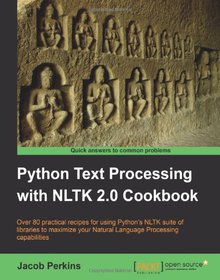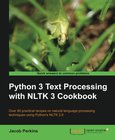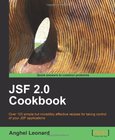Python Text Processing with NLTK 2.0 Cookbook

Book Details:
| Publisher: | Packt Publishing |
| Series: | Packt , Cookbook |
| Author: | Jacob Perkins |
| Edition: | 1 |
| ISBN-10: | 1849513600 |
| ISBN-13: | 9781849513609 |
| Pages: | 272 |
| Published: | Nov 11 2010 |
| Posted: | Nov 19 2014 |
| Language: | English |
| Book format: | |
| Book size: | 17.88 MB |
Book Description:
Use Python's NLTK suite of libraries to maximize your Natural Language Processing capabilities. Quickly get to grips with Natural Language Processing ? with Text Analysis, Text Mining, and beyond. Learn how machines and crawlers interpret and process natural languages. Easily work with huge amounts of data and learn how to handle distributed processing. Part of Packt's Cookbook series: Each recipe is a carefully organized sequence of instructions to complete the task as efficiently as possible In Detail Natural Language Processing is used everywhere ? in search engines, spell checkers, mobile phones, computer games ? even your washing machine. Python's Natural Language Toolkit (NLTK) suite of libraries has rapidly emerged as one of the most efficient tools for Natural Language Processing. You want to employ nothing less than the best techniques in Natural Language Processing ? and this book is your answer. Python Text Processing with NLTK 2.0 Cookbook is your handy and illustrative guide, which will walk you through all the Natural Language Processing techniques in a step?by-step manner. It will demystify the advanced features of text analysis and text mining using the comprehensive NLTK suite. This book cuts short the preamble and you dive right into the science of text processing with a practical hands-on approach. Get started off with learning tokenization of text. Get an overview of WordNet and how to use it. Learn the basics as well as advanced features of Stemming and Lemmatization. Discover various ways to replace words with simpler and more common (read: more searched) variants. Create your own corpora and learn to create custom corpus readers for JSON files as well as for data stored in MongoDB. Use and manipulate POS taggers. Transform and normalize parsed chunks to produce a canonical form without changing their meaning. Dig into feature extraction and text classification. Learn how to easily handle huge amounts of data without any loss in efficiency or speed. This book will teach you all that and beyond, in a hands-on learn-by-doing manner. Make yourself an expert in using the NLTK for Natural Language Processing with this handy companion. What you will learn from this book. Learn Text categorization and Topic identification. Learn Stemming and Lemmatization and how to go beyond the usual spell checker. Replace negations with antonyms in your text. Learn to tokenize words into lists of sentences and words, and gain an insight into WordNet. Transform and manipulate chunks and trees. Learn advanced features of corpus readers and create your own custom corpora. Tag different parts of speech by creating, training, and using a part-of-speech tagger. Improve accuracy by combining multiple part-of-speech taggers. Learn how to do partial parsing to extract small chunks of text from a part-of-speech tagged sentence. Produce an alternative canonical form without changing the meaning by normalizing parsed chunks. Learn how search engines use Natural Language Processing to process text. Make your site more discoverable by learning how to automatically replace words with more searched equivalents. Parse dates, times, and HTML. Train and manipulate different types of classifiers Approach The learn-by-doing approach of this book will enable you to dive right into the heart of text processing from the very first page. Each recipe is carefully designed to fulfill your appetite for Natural Language Processing. Packed with numerous illustrative examples and code samples, it will make the task of using the NLTK for Natural Language Processing easy and straightforward. Who this book is written for This book is for Python programmers who want to quickly get to grips with using the NLTK for Natural Language Processing. Familiarity with basic text processing concepts is required. Programmers experienced in the NLTK will also find it useful. Students of linguistics will find it invaluable.
Download Link:
Related Books:
Python 3 Text Processing with NLTK 3 Cookbook
Over 80 practical recipes on natural language processing techniques using Python's NLTK 3.0 About This BookBreak text down into its component parts for spelling correction, feature extraction, and phrase transformationLearn how to do custom sentiment analysis and named entity recognitionWork through the natural language processing concepts with simple and easy-to-follow programming recipesWho This Book Is ForThis book is intended for Python programmers interested in learning how to do natural language processing. Maybe you've learned the limits of regular expressions the hard way, or you've realized that human language cannot be deterministically parsed like a computer language. Perhaps you have more text than you know what to do with, and need autom...
JSF 2.0 Cookbook
The JSF 2.0 Cookbook contains step-by-step instructions for JSF users to build desktop-style interfaces in their own web applications. The book is designed so that you can refer to it chapter by chapter, or you can look at the list of recipes and read them in no particular order. This book is for two types of audience: Newcomers who know the basics of JSF but are yet to develop real JSF applications. JSF developers who have previous experience but are lacking best practices and a standard way of implementing functionality...
The Object Primer
Agile Model-Driven Development with UML 2.0
3rd Edition
Scott Ambler, award-winning author of Building Object Applications that Work, Process Patterns, and More Process Patterns, has revised his acclaimed first book, The Object Primer. Long prized by both students and professionals as the best introduction to object-oriented technology, this book is now completely up-to-date, with all modeling notation rewritten in the just-released UML 2.0. All chapters have been revised to take advantage of Agile Modeling (AM), which is presented in the new chapter 2 along with other important new modeling techniques. Review questions at the end of each chapter allow readers to test their newly acquired knowledge. In addi...
2007 - 2021 © eBooks-IT.org



